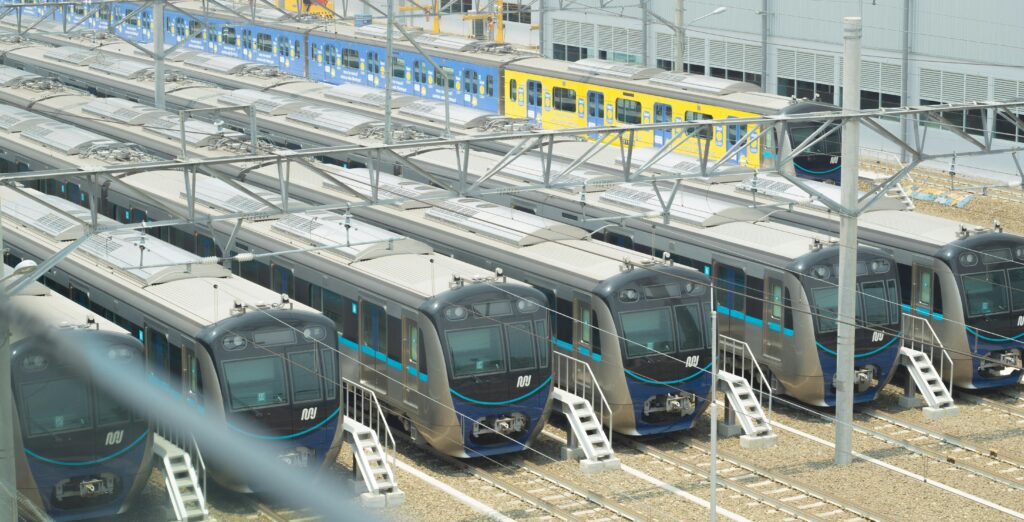Our Rail Fleet Size & Headway Calculator is a free online tool designed to help planners, engineers, and students estimate the number of trains required to operate a rail service. By entering key inputs such as route length, ridership, train capacity, dwell times, and operating hours, the calculator provides an estimate of:
- Required fleet size (trains in service)
- Reserve trains based on a chosen spare ratio
- Total fleet requirement
- Suggested operating headway (minutes)
- Round-trip travel time (RTT)
How to Use This Tool
- Enter the route length, daily ridership, and number of stations.
- Adjust operational assumptions like average speed, dwell time, layover time, and train capacity.
- Select operating hours and a reserve percentage.
- Click Calculate to get an instant estimate of fleet size and headway.
This calculator is helpful for rough planning, teaching, and preliminary feasibility assessments.
You can also try our bus fleet size calculator.
Rail Fleet & Headway Calculator
Clockface scheduling, peak-hour sizing, turnback feasibility check.
Disclaimer
This Rail Fleet Size Calculator is provided as a conceptual planning tool. Results are illustrative only and should not be used as a substitute for a detailed engineering study or operational simulation.
Real-world rail fleet sizing requires consideration of:
- Peak-hour, peak-direction demand (PPHPD)
- Signal system constraints and minimum headways
- Terminal and depot capacity
- Maintenance cycles and availability rates
- Financial and policy factors
For detailed, project-specific fleet sizing studies in rail, please contact Arterials — our team can provide advanced transport modelling and feasibility analysis tailored to your corridor or project.
Why Rail Fleet Sizing Matters
Fleet sizing in rail systems is one of the most critical planning steps. The number of trains required affects not only the capital investment but also service quality and passenger satisfaction.
Key considerations this tool supports include:
- Matching capacity to peak passenger demand
- Understanding how round-trip time and turnback layovers impact the number of trains needed
- Estimating headways to meet service frequency targets
- Planning for reserve/spare trains to account for maintenance and operational resilience
This tool helps illustrate how changes in assumptions (e.g., higher ridership, longer dwell times, faster speeds) can significantly change the fleet requirement for rail operations.
Frequently Asked Questions (FAQ) on Rail Fleet Sizing
How is rail fleet size calculated?
Rail fleet size is usually calculated by dividing the round-trip time (RTT) by the headway (time between train departures). This gives the number of trains required to keep service operating. Additional reserve/spare trains are then added to cover maintenance and reliability needs.
What is headway in rail operations?
Headway is the time interval between two consecutive trains traveling in the same direction on the same line. For example, a 5-minute headway means one train departs every 5 minutes. Shorter headways provide higher frequency and capacity but require more trains and stronger signaling systems.
What factors influence fleet sizing in rail?
Key factors include:
- Route length and average operating speed
- Station dwell times and terminal turnaround times
- Peak passenger demand (PPHPD)
- Train capacity
- Operating hours per day
- Signal and infrastructure constraints
Why do rail systems need reserve trains?
Reserve trains (also called spares or standby fleet) are required to replace trains that are out of service due to maintenance, inspections, or unexpected failures. Typical spare ratios range from 10–20% depending on system size and reliability requirements.
Can this tool replace a professional fleet sizing study?
No. This calculator is a conceptual planning tool meant for education, early-stage feasibility, and “what-if” testing. Detailed fleet sizing requires specialized modelling, peak-hour analysis, and infrastructure review. For professional studies, you can contact Arterials to get expert consultancy support.

